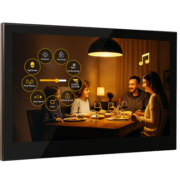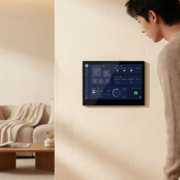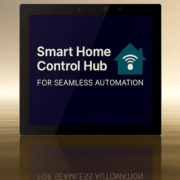What Is a Smart Home Device?
A smart home device is any electronic gadget or appliance that connects to a home network—typically via Wi-Fi, Bluetooth, Zigbee, or Z-Wave—and can be controlled remotely through a smartphone, tablet, voice assistant, or central smart home control panel.
Unlike traditional devices, smart devices are designed to automate, monitor, and respond to commands or conditions in real time. These devices can work independently or as part of a broader home automation system.
Some common categories of smart home devices include:
- Smart lighting (e.g., bulbs that change color or brightness on command)
- Smart thermostats (e.g., automatically adjusting temperature based on preferences)
- Smart locks and doorbells (e.g., remotely unlock your door or view visitors)
- Security cameras and sensors
- Smart plugs and switches
- Voice assistants (e.g., Amazon Alexa, Google Assistant)
- Smart home control panels (e.g., wall-mounted tablets like Portworld’s YC-SM10P)
Core Features of Smart Home Devices
- Connectivity
- Smart devices communicate over wireless protocols and integrate with home automation platforms, allowing centralized control and inter-device interaction.
- Remote Control
- You can manage and monitor smart devices from anywhere using a mobile app or smart panel interface.
- Automation
- Smart devices support automated actions triggered by schedules, sensor data, or other device states—for example, turning on lights when motion is detected.
- Voice Control Compatibility
- Most smart home devices are compatible with voice assistants, enabling hands-free control with simple commands.
- Data & Feedback
- They often provide real-time data and status updates, such as energy consumption, security alerts, or temperature readings.
Examples of Smart Home Devices in Action
- A smart thermostat like Nest learns your temperature preferences and adjusts settings to save energy.
- A smart plug can turn off an iron or coffee maker when you’re away from home.
- A smart lock allows keyless entry and remote access for deliveries or guests.
- A smart control panel, such as Portworld’s Android-powered YC-SM55P, lets you manage lighting, curtains, HVAC, and more—all from a sleek wall-mounted display.
Benefits of Smart Home Devices
- Convenience – Control your home from your phone or with your voice.
- Energy Efficiency – Monitor and reduce power consumption intelligently.
- Security – Get instant alerts, check camera feeds, and lock doors remotely.
- Customization – Personalize scenes for different moods or times of day.
- Accessibility – Helpful for the elderly, disabled, or tech-savvy homeowners.
The Role of Smart Home Panels in Device Management
While mobile apps and voice assistants are common control tools, dedicated smart home control panels offer a more reliable, secure, and intuitive experience. Portworld’s Android-based panels like the YC-SM08M and YC-SM10P serve as the command center of a smart home, supporting multiple device integrations, user-friendly UIs, and even third-party app compatibility.
They are particularly ideal for smart residences, hotels, office buildings, and commercial automation systems—where centralized, wall-mounted access improves usability and aesthetics.





